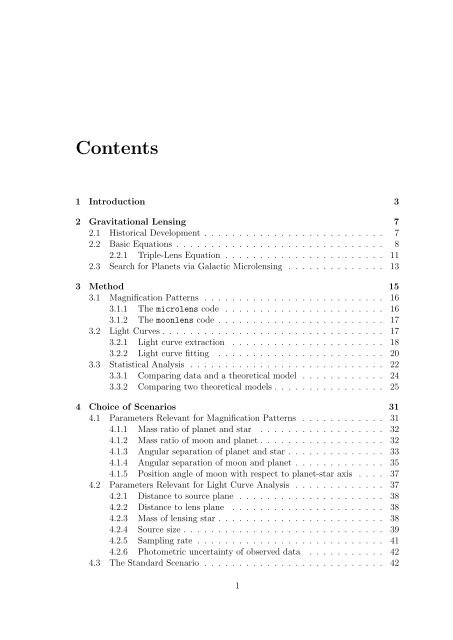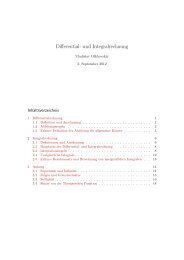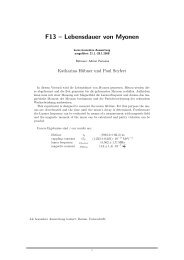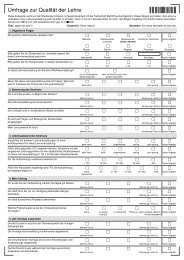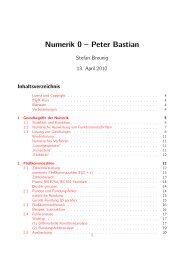Extrasolar Moons as Gravitational Microlenses Christine Liebig
Extrasolar Moons as Gravitational Microlenses Christine Liebig
Extrasolar Moons as Gravitational Microlenses Christine Liebig
You also want an ePaper? Increase the reach of your titles
YUMPU automatically turns print PDFs into web optimized ePapers that Google loves.
Contents<br />
1 Introduction 3<br />
2 <strong>Gravitational</strong> Lensing 7<br />
2.1 Historical Development . . . . . . . . . . . . . . . . . . . . . . . . . . 7<br />
2.2 B<strong>as</strong>ic Equations . . . . . . . . . . . . . . . . . . . . . . . . . . . . . . 8<br />
2.2.1 Triple-Lens Equation . . . . . . . . . . . . . . . . . . . . . . . 11<br />
2.3 Search for Planets via Galactic Microlensing . . . . . . . . . . . . . . 13<br />
3 Method 15<br />
3.1 Magnification Patterns . . . . . . . . . . . . . . . . . . . . . . . . . . 16<br />
3.1.1 The microlens code . . . . . . . . . . . . . . . . . . . . . . . 16<br />
3.1.2 The moonlens code . . . . . . . . . . . . . . . . . . . . . . . . 17<br />
3.2 Light Curves . . . . . . . . . . . . . . . . . . . . . . . . . . . . . . . . 17<br />
3.2.1 Light curve extraction . . . . . . . . . . . . . . . . . . . . . . 18<br />
3.2.2 Light curve fitting . . . . . . . . . . . . . . . . . . . . . . . . 20<br />
3.3 Statistical Analysis . . . . . . . . . . . . . . . . . . . . . . . . . . . . 22<br />
3.3.1 Comparing data and a theoretical model . . . . . . . . . . . . 24<br />
3.3.2 Comparing two theoretical models . . . . . . . . . . . . . . . . 25<br />
4 Choice of Scenarios 31<br />
4.1 Parameters Relevant for Magnification Patterns . . . . . . . . . . . . 31<br />
4.1.1 M<strong>as</strong>s ratio of planet and star . . . . . . . . . . . . . . . . . . 32<br />
4.1.2 M<strong>as</strong>s ratio of moon and planet . . . . . . . . . . . . . . . . . . 32<br />
4.1.3 Angular separation of planet and star . . . . . . . . . . . . . . 33<br />
4.1.4 Angular separation of moon and planet . . . . . . . . . . . . . 35<br />
4.1.5 Position angle of moon with respect to planet-star axis . . . . 37<br />
4.2 Parameters Relevant for Light Curve Analysis . . . . . . . . . . . . . 37<br />
4.2.1 Distance to source plane . . . . . . . . . . . . . . . . . . . . . 38<br />
4.2.2 Distance to lens plane . . . . . . . . . . . . . . . . . . . . . . 38<br />
4.2.3 M<strong>as</strong>s of lensing star . . . . . . . . . . . . . . . . . . . . . . . . 38<br />
4.2.4 Source size . . . . . . . . . . . . . . . . . . . . . . . . . . . . . 39<br />
4.2.5 Sampling rate . . . . . . . . . . . . . . . . . . . . . . . . . . . 41<br />
4.2.6 Photometric uncertainty of observed data . . . . . . . . . . . 42<br />
4.3 The Standard Scenario . . . . . . . . . . . . . . . . . . . . . . . . . . 42<br />
1


